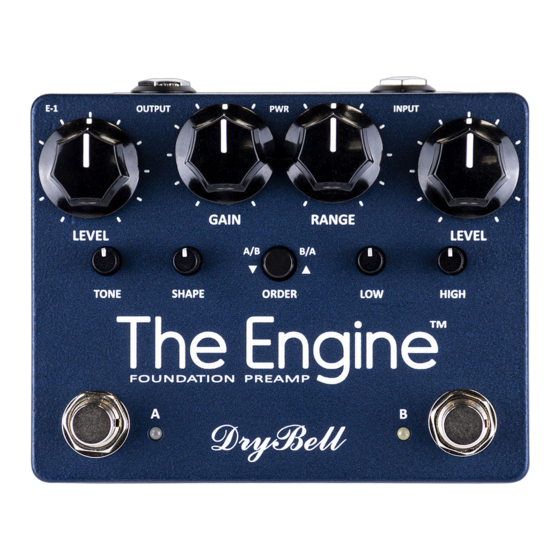DryBell The Engine User Manual
Browse online or download pdf User Manual for Amplifier DryBell The Engine. DryBell The Engine 2 pages.

The Engine is a highly versatile and fully analog foundation preamp pedal with distinct voicing inspired by 60's British classic amps
and sounds. It covers all the classic overdriven tones on a variety of amps and can be pushed even more with our take on the classic
Range(master) and a powerful EQ/Boost section.
I N T R O D U C T I O N
Thank you for purchasing The Engine pedal from DryBell, Croatia. The Engine's unique synergy of dynamic overdriven foundation tone combined
with a sparkling Range boost will give you a huge sonic world to explore. It consists of two fully Analog sections. Side A is very carefully tuned to
capture the sound, feel and dynamic response of a real 60's British non-master-volume amp. You can easily get that cranked Tube-like distortion
sound but without the need to play at ear-shattering levels. Side B's most powerful feature Range is our take on the Treble Booster from the 60's.
Besides that, the high headroom and distortion-free Clean Boost and versatile Low & High EQ will help you even further in tailoring your tone.
Stacking these A&B sections (A>B or B>A) with the Order switch can yield numerous combinations of incredibly rich sounds.
LEVEL (A) (big knob on Side A) 1
Controls the overall output volume of Side A. This control alone is enough to push the front end of any amp into natural overdrive.
GAIN (big knob on Side A) 2
Adds additional grit & dirt to your tone. It can go from subtle Crunch to full blown Distortion with a simple twist of the knob. Side A is very touch
sensitive so the amount of dirt on tap is easily controlled with your pick attack.
TONE (small pot on Side A) 3
Controls the high frequency spectrum of Side A. When used in conjunction with Side B's tone controls, The Engine will bring out the finest details of
any amp you use.
SHAPE (small pot on Side A) 4
Changes the overall character and level of mid frequencies. It's a key feature for adjusting the voice of your foundation tone and it can really help
you fine tune the tonal details in your sound on any amp that you're playing.
ORDER (pushbutton switch) 5
Controls the side stacking order of the Preamp (A > B or B > A). A very useful control for selecting between "more gain" or "more volume" and it
really helps in terms of pedalboard position.
LEVEL (B) (big knob on Side B) 6
Controls the overall output volume of Side B. It acts as a remarkably high headroom and distortion free clean Boost, thanks to the high internal
power supply voltage (23V). Turned fully CW, the gain of this boost stage is 22.4dB or can be reduced up to 7dB at its minimum setting (-7dB turned
fully CCW). Unity gain zone (0dB) is approx. at 10 o'clock.
RANGE (big knob on Side B) 7
Controls specific mid frequencies needed for pushing through the mix while adding a glorious sparkle and bite to your tone. It's the most powerful
element of Side B and very similar to the old classic "Rangemaster". Unity gain is at 12 o'clock.
LOW & HIGH (small pots on Side B) 8,9
LOW controls the low frequencies from -15.8dB up to +9.3 dB. HIGH controls the high frequencies from -13.2dB up to +7.2dB. They are not
symmetrical tone controls and both knobs have unity gain position at approx. 12:30. Both are active controls and carefully tuned to be compatible
with a wide range of amps and are a great addition to the Range control.
BYPASS SYSTEM (footswitches, LEDs) 10,11,12,13
The Engine has a buffered bypass. Each time you press the footswitch the effect is turned ON or OFF. When Side A is active, the red LED will light
up. The white LED will light up for Side B. The bypass system has a built-in high headroom, ultra-low noise buffer circuit, designed to have no signal
loss, unlike most classic transistor buffered pedals.
INPUT and OUTPUT (top mounted jacks) 14,15
The input is on the right and the output on the left side of the pedal.
POWER SUPPLY (no battery, power supply only) 16
We recommend a regulated 9VDC/100mA PSU (not included). Maximum allowed power supply voltage is 18V (must be regulated!). Higher voltages
than 9V (18V max) will affect the tone, dynamics and internal headroom of The Engine's side A only. Side B has a voltage regulator inside and it
won't be affected by higher voltage. The current consumption for use with electric guitar is about 83mA. If you connect another device with much
higher output than an electric guitar, we recommend using a power supply with 150mA output. The Engine has internal protection against reverse
power polarity and electrostatic discharges.
PACKAGE CONTENTS
The Engine pedal, four rubber feet and user's manual.
- A powerful voice for musicians.
DryBell
The Engine E-1, User's manual, rev.1.1 , 06/2020
Doc. No. DM1007 / Page 1
